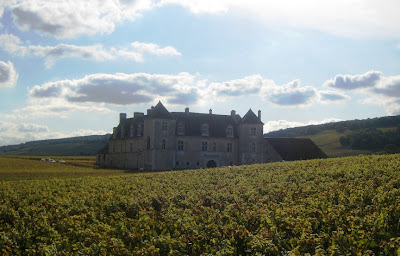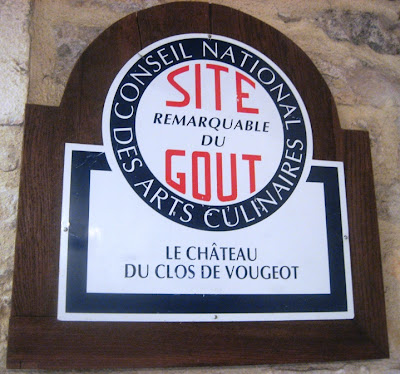To experience the Côte d’Or or ‘golden slope’ in all its glory, then fall is the time to go, just after harvest, when the leaves on the vines on the south-eastern facing vineyard slopes turn golden in the late afternoon sun. Yet for a wine lover, a visit to this heartland of Burgundy, a couple of hours southeast of Paris, is magical whenever you visit.
My first drive through the Burgundy vineyards was at a mere 17 years old. In England, I had already enjoyed wine (in moderation, you understand) with my family, and had tasted wines from such legendary names as Nuits St-Georges, Gevrey-Chambertin, Beaune, Meursault and Volnay. Studying French at school, I knew how to pronounce the names and where they came from too. That summer, when High School was over, I set off across the channel with two friends on a driving and camping holiday.

Chateau du Clos de Vougeot
We were rarely on freeways, and south of Dijon, we ended up on what to wine people is the legendary Route Nationale 74. My friends couldn’t comprehend my bubbling excitement when we were driving through what in the 1970s were simple French villages with the names of Gevrey, Morey, Vosne, Nuits, … I never forgot that first drive and still today a drive down the Route des Grands Crus as it is now grandly named, gives me a frisson of excitement.
Understanding Burgundy
Getting to grips with the wines of Burgundy is both easy and impossible at the same time. Two principal grape varieties are used: Chardonnay for whites (and a little Aligoté used in places) and Pinot Noir for reds (with Gamay further south in the Mâconnais and Beaujolais), that’s the easy part. But, the hierarchy of regional, village, Premier Crus and Grands Crus, along with a plethora of small single estates (domaines) and merchants (négociants) making wines under a myriad of labels are just the start of the complications. To get the most out of a visit there, it’s worth reading up on a few of the basics in advance, but fear not, even in France they know that the intricacy of Burgundy is impossible for outsiders to understand fully. Relax and enjoy the taste of these wonderful wines.
The Côte d’Or is only around 50km (30 miles) north to south and split into the Côte de Nuits, running from south of Dijon to just north of Beaune, and the Côte de Beaune, running onwards south towards the small town of Chagny, north of Chalon-sur-Saône. It’s a short distance to travel, but if you add in a few vineyard walks, you could easily spend a week exploring the wine cellars, filling up on delicious food, and perusing the shops, museums and bars of the town of Beaune.
Côte de Nuits – home to the most famous and expensive Pinot Noirs
On the Wine Travel Guides Côte de Nuits guide the introduction explains: “the visitor who travels the Route des Grand Crus, a small road through the vines, will marvel at the small size of the fabled appellations, and begin to understand the all important geography of the region. Many of the vineyards were first planted over a thousand years ago by monks as much of the land was owned by the church.”
The sense of history pervades everywhere, from walking through the small streets of Gevrey-Chambertin or Nuits St-Georges, to a visit to the famous Château du Clos de Vougeot, surrounded by vineyards and including a collection of centuries-old, huge wine presses. To visit wine producers here, be warned that most require an advance appointment, and the illustrious wine estates can simply not be visited without an introduction from an importer or distributor.


Gevrey-Chambertin has a helpful tourist office that will assist in setting up visits to producers, or you can try your luck in the small town at the shop for a very well respected wine estate, Domaine Heresztyn. To really get into the swing of Burgundy life, a long lunch may be called for. In the middle of Gevrey is Chez Guy, a bright, modern restaurant with delicious, traditional cuisine – their beef cheeks braised in red Burgundy are renowned. They also own a wine shop next door and will be happy to advise.
Côte de Beaune – Chardonnay’s original homeland
Beaune is many peoples’ favourite wine town in France, and it really is worth spending a day here. The town’s most famous landmark is the Hospice de Beaune, an old hospital for the poor, with an intricately colourful roof, typical of the region. Do make time to tour the hospices; it is extremely atmospheric visiting the dormitories where the poor were looked after, the superb reproduction of an old apothecary and a beautiful 20th century wine-themed tapestry by Jean Lurçat.
Before you venture into the Côte de Beaune vineyards, it is worth making some investments at the best wine-specialist book and gift shop in Europe, named Athenaeum, where you can arm yourself with wine guides in English, maps and much more. Beaune itself is full of wine merchants to visit, but these visits and tastings do tend to be a little over touristy and expensive; it is much better to venture south to explore the wine villages of Volnay or Pommard (for sublime reds), or Meursault, Puligny or Chassagne (for some of the world’s greatest dry white wines).

Hospices de Beaune
For a sensorial educational experience, reserve a tasting with lunch at Olivier Leflaive in Puligny-Montrachet, they also have a lovely hotel. Alternatively, somewhere really comfortable to stay, right in the centre of Beaune, is the Hotel Le Cep, with its 16th-18th century buildings and a lovely inner courtyard for breakfast. To eat, there are choices galore: I recently enjoyed a meal at the legendary Ma Cuisine, but that’s hard to get a reservation; a good alternative, just outside Beaune’s ramparts is Le Comptoir des Tontins. At both you will experience a relaxed atmosphere, with authentic Burgundian cuisine and of course, a great choice of wines.

All the above recommendations are detailed in our guides. Wine Travel Guides offers six micro-region guides to the Burgundy wine region, with details of wine producers to visit, places to stay, eat and shop, and good basic wine information too. All guides are free to view, or you pay a small price to download the PDF guides. Wandering Educators visitors can use the discount code D1WAND09 to purchase Gold membership (access to all PDF guides for 12 months) at a reduced price of £25 (approx. $43).
Wink Lorch is the Wine Travel Guide Editor for Wandering Educators
All photos courtesy and copyright Wink Lorch
